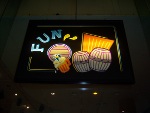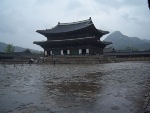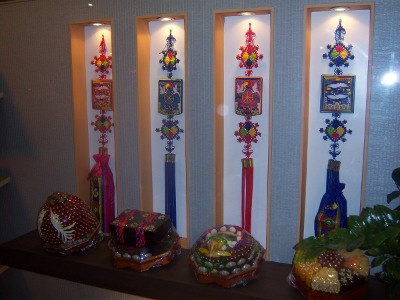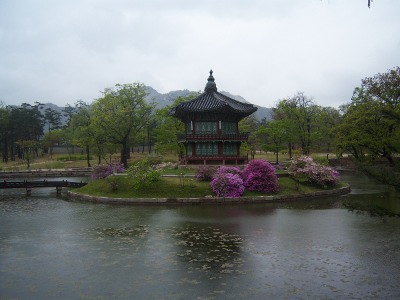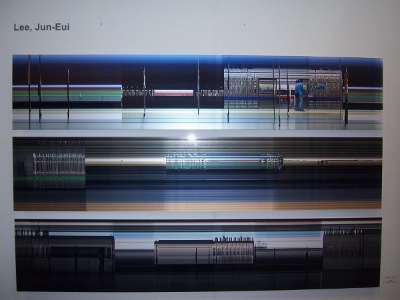Korean History
Fifty years ago in our study of Chinese culture we were told of three philosophical schools, Confucian, Taoist and Buddhist, and taught that they were amicably synthesized in later ages. What an idyllic vision, compared to the realities of Korean history and the role that Confucianism and Buddhism, especially, played in its development, for there seems to have been no philosophical activity unconditioned by politics.
As I understand it, in 1960 Ki-baik Lee produced, in Korean, a book whose English title was rendered in 1984, by his translator Edward W. Wagner, A New History of Korea. Subsequently it was edited and abridged by Carter J. Eckert, Ki-baik Lee himself, Young Ick Lew, Michael Robinson and Edgar W. Wagner and re-published in 1990 for the Korea Institute, Harvard University, by Ilchokak Publishers (Seoul).
Lee offers a very un-idyllic account of the historical realities and the realpolitik that governed the reception, of Buddhism, Confucianism and Neo-Confucianism in Korea. I thought that the reader might enjoy a pastiche of quotations from Lee. We begin with the reception of Avatamsaka doctrine (in Chinese, Hua-yen; in Korean, Hwaom) during the T’ang, contemporary with the Silla dynasty centered in Gyeongju.
Lee I
Hwaom taught the doctrine of all encompassing harmony, that the One contains the multitude and the multitude, the One, a concept that embraces the myriad sentient beings within the single Buddha mind. This doctrine was well suited to a centralized power structure under an authoritarian monarchy and surely was one reason why the Hwaom teaching was welcomed by the ruling elite of Unified Silla’s aristocracy.
Later “Pure Land” Buddhism became the focus for the Korean masses, in part because its practice was accessible, in part because it offered hope of an escape from the despair of lives filled with day-to-day suffering, a condition brought about by the gross inequities in Silla society under its authoritarian rulers. It was during the Unified Silla period that Confucianism came to rival Buddhism as an alternate system of thought.
A National Confucian College was established in 682. By the mid-eighth century its curriculum consisted of the Analects of Confucius, the Classic of Filial Piety and other classic Chinese texts on the rites, history and literature. This national educational institution made possible the inauguration of a state examination system for the election of government officials in 788 based on proficiency in reading Chinese texts.
Culture of the Gentry Period. During the height of royal authoritarian rule in Silla, Confucianism gradually won wider acceptance as a doctrine providing a unique moral basis for effective government. But during the later Silla, when the bone-rank system was in decline, it emerged as an ideology of political reform. The number of Confucian students going abroad to study Confucianism in T’ang China increased dramatically.
In the end it was Confucian scholars of this persuasion who provided the political ideology of the new Koryo dynasty. A new method arose for the selection of personnel, the state civil service exams. There were three basic types: the Composition Exam, the Classics Exam, and the Miscellaneous Exam. The composition course tested candidates on their ability to compose in set Chinese literary forms.
The classics course examined knowledge of the canonical Confucian works. Both were conducted for the purpose of selecting civil officials, but the composition exam was regarded as by far the more important, and thus fewer than one out of ten candidates elected to sit for the Classics Exam. Miscellaneous Exams were held to select specialists in areas of technical knowledge, such as law, medicine, etc.
The Aristocratic Culture of Koryo. In a state committed to the principle of rule by civil officials in accordance with Confucian political ideas, it was natural that Confucianism prosper. But in Koryo society the importance attached to aristocratic pedigree acted to modify certain features of Confucian doctrine. This can be seen in the rise of private academies as the principal agencies for the education of aristocratic youth.
The growing acceptance of Confucianism encouraged a rational approach to the problems of human society. Confucianism was looked upon as the orthodox doctrine by which to order family relationships and to govern the state, and both the monarch and the aristocracy came to regard it as vital to the moral cultivation of political leaders. Native Korean values, however, dictated that conversion be less than whole-hearted.
Koryo Confucians by no means rejected Buddhism. Regarding it as a doctrine of spiritual tranquility and otherworldly salvation, they felt that it complemented, and could co-exist with, Confucianism. Accordingly, many were versed in both and so differed from Confucian scholars of late Koryo and the Choson dynasty. Meanwhile, Buddhism became integral to everyday life in Koryo and defined its cultural achievement.
Lee II
The emergence of the Literati in the Choson. Yi Song-gye rose to prominence by repelling a Japanese invasion and using his newly won power to carry out a sweeping land reform, advocated all along by the newly risen literati class but hitherto impossible to put into effect. The advocates of literati reform, by and large adherents of Neo-Confucianism, not only opposed the aristocrats but also the Buddhist establishment.
The special characteristic of late Koryo Confucianism lay in its acceptance of Neo-Confucian doctrine. Neo-Confucianism is a systematic philosophical Confucianism that explains the origins of man and the universe in metaphysical terms. Its political ethic stresses the mutual relationship of ruler and subject. It is an intolerant doctrine, quick to reject all other teachings. The literati made these doctrines their mainstay.
Historiography was prominent in this new world of scholarship. Today we are left with only the History of the Three Kingdoms, Korea’s oldest extant history. Composed as annals, it reflects an aristocratic point of view and adopts a Confucianist historiography; in other words, it is a frankly didactic work that evaluates the actors and events of Korea’s early history from the viewpoint of Confucian moralism.
During late Koryo there came to be practiced increasingly, by the non-professional and by the literati, to give expression to their sensibilities, what may be called a romantic style. This is seen in the frequency of the portrayals of the literatus as recluse, the pleasures of alfresco fellowship, the “four gentlemen”: plum, orchid and chrysanthemum but above all bamboo, whose pliancy was symbolic of the flexible official.
These honorable men, who weathered political storms without giving up their integrity, became the dominant social class in the Choson. Called the “yangban,” they served as civil or military officials. Their duty required that they devote themselves exclusively to such self-cultivation as Confucian doctrine holds necessary for the governing of others. Their sole profession was the exercise of public office and duties.
Their function was to fashion an ideal Confucian polity through the moral cultivation of the Choson people. These duties were discharged by a hereditary class of petty functionaries, the hyangni, an indigenous element, also unsalaried, a combination that proved all too conducive to venality and the exploitation of the peasant population. To them were added a military class of private armed forces, eventually abolished in 1400.
Qualifying examinations for civil offices were conducted at two levels, the licentiate (lower level) and the erudite (higher level). The licentiate exams were of two kinds: The Classics Licentiate Exam, which covered the Four Books and the Five Classics of China, and the Literary Licentiate Exam, which tested skill in composing in Chinese literary forms. The Military Exam tested skills in basic military arts.
Beginning in 1498 occurred a series of Literati Purges that brought to the fore younger officials committed to an abstract Neo-Confucian ethos demanding adherence to unrealistically high moral standards in the formulation and execution of public policy. Political power shifted to the Seoul Neo-Confucian literati who were in large part members of the very same lineages that the so-called meritorious elite had represented.
As a contemporary observed, “In the Literati Purges the evil elements persecuted the good; in the [post-1575] Factional Strife, the good fought with the good.” That is, by the later 16th century, the ruling elite had become ideologically homogenized as “good” Neo-Confucians, so that there was no longer a “bad” element to oppose. Private academies (sowon) occupied a position earlier enjoyed by Buddhist temples in Koryo.
Lee III
The Culture of the Neo-Confucian Literati. Exigencies of the time, then, produced an efflorescence of Neo-Confucian doctrine promulgated by great thinkers. Neo-Confucianism divided existence into two inseparable components, i and ki (in Chinese, li and ch’i). The one, i, is the formative element that accounts for what things are and how they should behave, whereas the other, ki, is the concretizing, energizing element.
The two are inseparable, since i (principle) could not exist concretely without ki (force), and ki would be but formless and directionless energy without i. Based on this dualism, two distinct schools of Neo-Confucian thought developed in Korea, one giving primary emphasis to i, the other primacy emphasis to ki. The thinker who first put forward a full explication of the view that stressed the primary efficacy of i was Yi Hwang.
A philosophical giant, he is known as Korea’s Chu Hsi. He elaborated the role of i in the human psyche and emphasized personal experience and moral self-cultivation as the essence of learning, believing that spiritual essence and personal integrity are found in individual apperception or moral principle and its realization in practice. This school of thought exerted influence on Confucian scholarship in Japan as well.
Yi Hwang’s emphasis on the role of i (one of the two terms established by Sung Neo-Confucanism) was countered by a school that gave emphasis to ki. The man who completed the formulation of this view was Yi I (known as Yulgok, 1536-1584). Fundamentally, the theory of the primacy of ki regarded the force of ki rather than the mysterious formative power of i as the fundamental constitutive factor of the universe.
Ultimately this view leads to seeing i as nothing but the principle inherent in ki. It emphasizes the search for moral principles but looks outward rather than inward and favors intellectual rather than spiritual perception. It values external experience and breadth of learning. Yi I was famed not only as a philosopher but also as a reformer who put forward many proposals with regard to government, economy and national defense.
In the 17th century there developed a ritual Neo-Confucianism. Many literati became virtually excluded from participation in the political process and some sought fulfillment by establishing sowon in the countryside localities where they lived, both to educate their youth and to carry on the teachings of earlier generations of Neo-Confucian literati. As a result nearly three hundred sowon were founded during Sukong’s reign.
Content now to forgo official careers, the sowon scholars came to represent the mainstream of Confucian scholarship, winning respect as “rustic literati” (sallim). Through government policy aimed at preventing their alienation some were appointed to sinecures in the National Confucian Academy. The officers who presided over rites paid homage to Confucius. But a greater number of “idle” literati served as advisers.
In the 18th and 19th centuries Sirhak thinkers appeared among the Southern faction excluded from important government positions. Their major concern was to illuminate the history and practice of political, economic and social institutions. Not limiting their scholarship to such fields, they extended their inquiries to embrace other areas ― the Chinese classics, historiography, geography, natural science and agriculture.
An alternate school, the Northern Learning, developed in the 18th century. It admired the achievements of Chinese civilization, but its principal concern was to bring about change in Korea. Accordingly, they criticized in writing the yangban society of the age. They assailed the parasitic life of yangban Confucianists who performed no productive labor and, to the contrary, themselves served as advocates for commercial activity.
Lee IV
Western Science and Technology. Like Catholicism, western science and technology entered Korea through Ming China, whence it had been brought by the Jesuits. During the intellectual ferment of the 17th and 18th centuries dissenting views also emerged within the Neo-Confucianist school itself. Yun Hyu and Pak Se-dang expressed their dissatisfaction with orthodoxy. In his Exegesis of the Doctrine of the Mean Yun Hyu attacked Chu Hsi, earning for himself the appellation “traitor to true Confucianism.”
Defeated by Song Si-yol in the mourning rites controversy, he was executed. Pak Se-dang not only deviated from Chu Hsi’s interpretations of Confucius but offered fresh analyses of Lao Tzu and Chuang Tzu as well. For this temerity he too was branded a heretic. Chong Yao-yong likewise sought to reinterpret Confucius. Meanwhile, the “heretical” ideas of Wang Yang-ming began to gain acceptance among some Korean scholars.
The 19th century. What attracted Koreans to Catholicism was above all its creed of equality, its view that all human beings are alike the children of God. It must have been a moving experience for commoners to number themselves among God’s children and worship Him on a basis of equality with the yangban. For women Catholicism had a corresponding appeal. Moreover, those who despaired responded with joyous belief to sermons about the kingdom of God. The vision of an afterlife was a powerful inducement.
Late in the century, however, anti-foreignism arose, even as the government pursued enlightened policies. The rejection of heterodoxy in favor of orthodoxy was its most virulent expression. Chu Hsi was used as the conceptual basis for “rejecting heterodoxy.” Any other ideology must be kept from Korean shores. This belief was held most strongly by those who did not actually participate in governmental affairs. It was inevitable that such worthies would react with unmitigated hostility toward most reform measures.
The 20th century. During the past century Protestantism and Buddhism both brought pressure to bear upon the Korean tradition of Confucianism. Korea, Professor Lee concludes, had not only been unified for over a millennium before 1945; until the 20th century it was an active and leading participant in East Asia’s Sinitic world civilization. Japan’s cultural achievements, in his view, resulted largely as a departure from Chinese culture. Korea’s, by contrast, resulted from a process of revitalization within the Chinese tradition.
Its accomplishments often rivaled those of China itself. In the realm of Neo-Confucian culture Korea’s contributions were “stellar,” to borrow an adjective used by Wm. Theodore de Bary, and were creatively adapted to Korean conditions and needs. Indeed, in Choson, Korea’s aristocratic elite were both self-consciously cosmopolitan and Korean, and they were capable, during China’s Ch’ing dynasty, for example, of looking down on China for abandoning cultural standards that they themselves continued to uphold.
Lee reaches some other surprising conclusions: citing the anthropologist Vincent Brant, he suggests that the communitarian values associated with Confucianism and regarded as an ethical resource in its late phase (by contrast with the spirit of individualism governing the industrial revolution in the West) are only half of the Korean story. Brant points to an equally persistent countervailing tendency toward individual self-assertion, and it may be that this combination of opposing values and the tensions between them, rather than communitarianism alone, provides the better understanding of Korean culture.
For of late South Korea has developed both an aggressive entrepreneurship and a close government-to-business relationship. Another point is that many of the Confucian values seen as factors in her economic growth ― filial piety and family loyalty, a conception of the state as an active moral agent, respect for hierarchy, emphasis on education, and concern with social harmony ― were already present in Korean culture (to varying degrees) long before the Neo-Confucianism of the Choson dynasty became the country’s ruling ideology. Choson merely served to diffuse such values throughout society.
